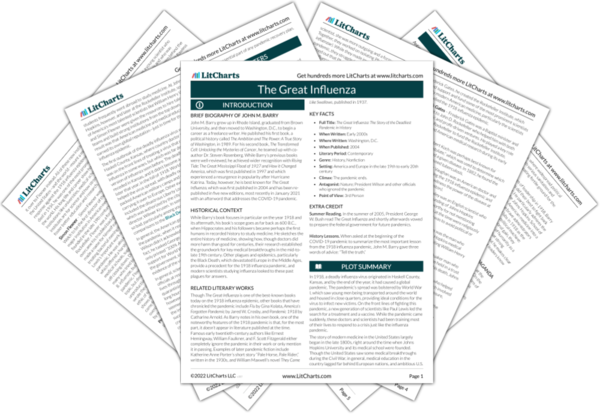William Henry Welch Quotes in The Great Influenza
Nothing about the boyhood or youth of William Henry Welch suggested his future.
As the virus moved, two parallel struggles emerged.
One encompassed all the nation. Within each city, within each factory, within each family, into each store, onto each farm, along the length of the track of the railroads, along the rivers and roads, deep into the bowels of mines and high along the ridges of the mountains, the virus would find its way. In the next weeks, the virus would test society as a whole and each element within it. Society would have to gather itself to meet this test, or collapse.
The other struggle lay within one tight community of scientists. They—men like Welch, Flexner, Cole, Avery, Lewis, Rosenau—had been drafted against their will into a race.
Nature chose to rage in 1918, and it chose the form of the influenza virus in which to do it. This meant that nature first crept upon the world in familiar, almost comic, form. It came in masquerade. Then it pulled down its mask and showed its fleshless bone.
By World War I, the revolution in American medicine led by William Welch had triumphed. That revolution had radically transformed American medicine, forcing its teaching, research, art, and practice through the filter of science.

William Henry Welch Quotes in The Great Influenza
Nothing about the boyhood or youth of William Henry Welch suggested his future.
As the virus moved, two parallel struggles emerged.
One encompassed all the nation. Within each city, within each factory, within each family, into each store, onto each farm, along the length of the track of the railroads, along the rivers and roads, deep into the bowels of mines and high along the ridges of the mountains, the virus would find its way. In the next weeks, the virus would test society as a whole and each element within it. Society would have to gather itself to meet this test, or collapse.
The other struggle lay within one tight community of scientists. They—men like Welch, Flexner, Cole, Avery, Lewis, Rosenau—had been drafted against their will into a race.
Nature chose to rage in 1918, and it chose the form of the influenza virus in which to do it. This meant that nature first crept upon the world in familiar, almost comic, form. It came in masquerade. Then it pulled down its mask and showed its fleshless bone.
By World War I, the revolution in American medicine led by William Welch had triumphed. That revolution had radically transformed American medicine, forcing its teaching, research, art, and practice through the filter of science.











